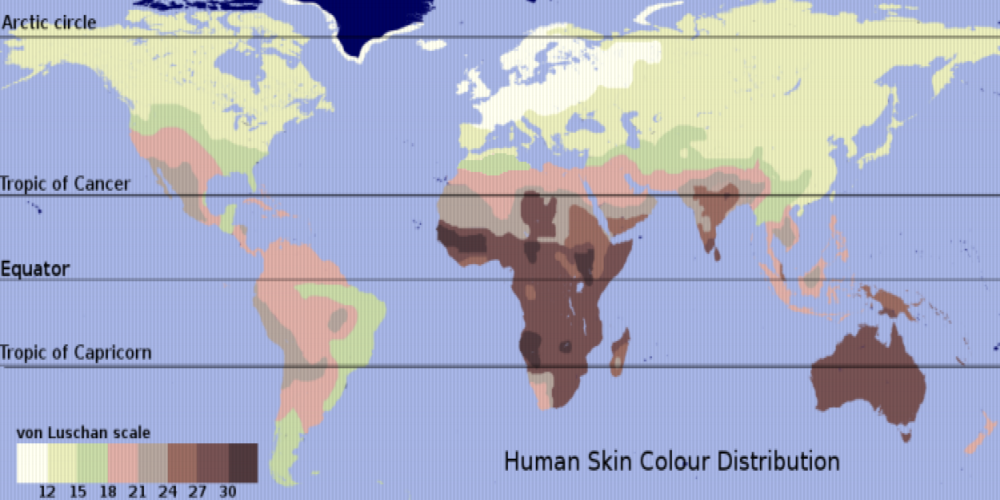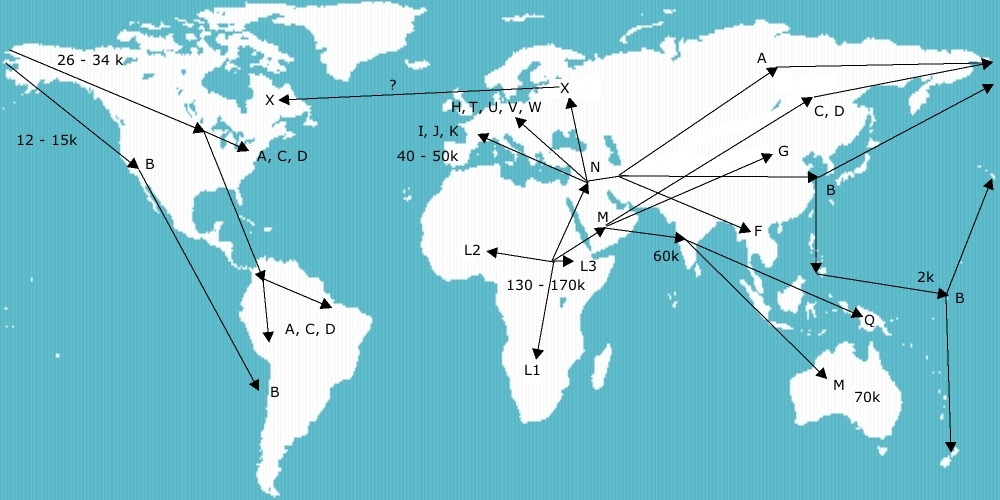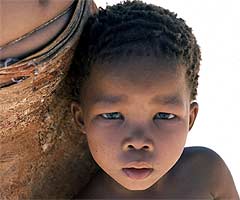Why White People Have Blue or Green Eyes
Dr. C. George Boeree
I like race. I know it sounds odd, even politically incorrect. But I really enjoy the differences among people around the world. One aspect of this is all our different cultures. But another is all our different physical types. I get a kick out of reading and thinking about how we got to look the way we look, where our characteristics came from, why they are there at all. And, I must admit, it does seem to me that there are some groupings when it comes to our physical differences, which we have been calling races for some time.
The races are definitely not "subspecies." All modern human beings are members of Homo sapiens sapiens - a single genus, species, and subspecies. To this extent, we are remarkably similar, sharing perhaps 99% of our genes. But that doesn't mean we are therefore all alike: We share 98% with the chimps, and even 90% with mice - and the differences there are quite striking!
Because the concept of race has been confused so thoroughly with our terrible history of racism, many avoid the term altogether. There is some justification. For example, there is no such thing as a "pure" race, and the races clearly blend into each other, unless dramatically transported to new regions. This is what has made race such a significant (and problematic) concept in the Americas, where the original native populations were confronted with European colonists and African slaves!
Skin
Speaking of the "red" man, the "white" man, and the "black" man, skin color is perhaps the first characteristic we think of when we think of race.
Skin, hair, and eye color are due to relative amounts of melanin. There are two kinds of melanin: Eumelanin is dark, with two types, black and brown. Pheomelanin is a light reddish brown. It is responsible for the color of lips, nipples, and naughty bits, as well as freckles, red hair and green eyes.
The experts are pretty much in agreement about how the varieties of skin color came about. They suggest that prehumans were likely white with fur - just like our relatives, the chimpanzees. As our hair became thinner, melanin came to the rescue to protect us from the sun's damaging ultraviolet rays. We became a brown people as our whiter relations died of skin cancer or from a lack of the B vitamin folate, which is needed for DNA synthesis, and without which we see more birth defects. Some people in Africa even evolved dark black skin.
Once people were out of Africa, there was a lot more variation in levels of sunlight. People in northern latitudes did not need as dark a skin for protection, and so the natural variations returned and some people became lighter again. Others, staying in southern latitudes such as India, Southeast Asia, and Australia, retained one level or another of darkness for protection. So, in Asia, we see a smooth range of skin tones from very light brown in Siberia to dark brown in India:1

In Europe, there was an odd mutation, something like albinism. It seems that in the far north, there isn't enough sun to help us manufacture vitamin D. So light - even white - skin became better for survival, because it can absorb more sunlight. This reduction in melanin was also reflected in blond and red hair and blue and green eyes.
Meanwhile, people moved into Siberia, a light brown in color. Some travelled over into the Americas. The ones that settled near the equator in Central and South America developed, as one might expect, darker skin. But they never got quite as dark as people in Africa or India because some of the genes that originally gave us very dark skin had disappeared from the Siberians before they left, and they haven't yet re-emerged.
Eskimos are rather dark for people who live further north than even the Scandinavians. How did they manage to keep their tans? The theory is that live on a diet very rich in fish, which, of course, has a high level of vitamin D. The need for vitamin D may also account for why some people - especially northern Europeans - became able to easily digest milk (lactose tolerance), a very recent mutation.
In a very similar way, we can see some of the differences in our builds as tied to latitudes and climate. There is something called Bergmann's rule, which says that mammals will tend to be larger (or taller, in our case), but with shorter arms and legs, in cold climates, and smaller, but with longer arms and legs, in warm climates. In cold climates, we need to conserve heat, so it helps to be large with as little skin surface as possible. In warm climates, we need to dissipate heat, so being small with lots of skin surface works best.
Hair
Genetically, Africans have more variety than other races. Every time a group advanced out of Africa, or from one isolated area to another even more isolated, another batch of genetic variations was left behind. But on the surface, it's caucasians that have the most variety, for the simple reason that they have a lot less melanin, which takes the darkness out of their skin, hair, and eyes to reveal other possibilities.
Hair color is determined by 4 to 6 genes, each with several alleles, some with incomplete dominance (i.e. not a matter of one thing or the other, but perhaps a mix of both - like pink carnations). The basic genes involved are for black hair (with a recessive allele for not-black), one for brown hair (with a recessive for blond), and one for red hair (with a dominant allele for not-red). Some of these genes are close to eye color genes on chromosomes 15 and 19, and tend to go along with those genes, which is why we tend to see certain combinations of hair and eye color more frequently than others.
Black is the most common hair color in the world, and is due to a large amount of eumelanin. Brown is also common, and is due to eumelanin mixed with a bit of pheomelanin. Blond is only found in about 2% of the world's population. It is due to very small amounts of melanin. Slight amounts of black, brown, and red make for all the variations we see in blonds - such as ash, flaxen, and strawberry blond. And red hair is the rarest of all, about 1% of the world. It is due to high levels of pheomelanin plus low levels of eumelanin.
If you are curious, gray hair is due to nothing but a little black melanin, and white hair is a matter of no melanin at all.
As you can see on this map, light colored hair is found primarily in scandinavia and the baltic sea area. Blond and red hair was probably more common in Europe centuries ago (as witnessed by Greek and Roman accounts), but being recessive, it has slowly receded northward. But you can still find blonds and redheads in places like Afghanistan and northern Pakistan, where the descendents of Indo-European invaders live.
Yellow: 80% or more with light hair2
Orange: 50 - 79%
Light brown: 20 - 49%
Dark brown: 1 - 19%
Black: 0%
Eyes
Eye color is determined by the amount of melanin (mostly eumelanin) in stroma of iris, plus density of the stroma cells. The stroma are those fine bundles of fibers that make the interesting little lines in your Iris.
You will have brown or black eyes if there is a great deal of eumelanin in the stroma. High pheomelanin will give you green eyes. And if there is very little melanin of any sort, your eyes will be blue, which is the color of the precursor to melanin, as well as the reflected color of the sky. If the melanin is extremely low, the blood vessels (red and blue) will make the eye appear a light purplish color.
Eye color seems to be mostly a matter of three genes: On chromosome 15, there is a gene labelled bey 1, which is called the central brown eye color gene, and bey 2. Bey 2 has a dominant allele for brown eyes, and a recessive one for blue eyes. There is also a gene on chromosome 19 called gey. It has a dominant allele for green eyes, and a recessive for blue. If you have two blue alleles at bey 2 and a green at gey, you will have green eyes. Blue alleles at bey 2 and blue at gey, and you will have blue eyes. If you have any brown alleles on bey 2, you will have brown eyes, no matter what you have at gey.
But, of course, things are more complicated than this. There are different degrees of darkness, for example, that allow some green to peek through light brown eyes to form hazel. And there are all sorts of variations on blue and brown as well. Nothing is ever simple.
Blood
But perhaps we should look at some of our inner differences to get at race. For example, we can look at blood types. Unfortunately, this approach doesn't get us too far. A is found most in Europe, Australia, and among north Canadian Indians, and least from Mexico down through South America. B type blood is found most in Asia, less in Africa, the Near East, and eastern Europe, and hardly at all in western Europe, among Australian Aborigines, and among American Indians. O is found at its highest levels among the American Indians and least among central Asians.
Rh factors are more interesting: Rh negative is found most among the Basques in Spain and France, with 35% showing Rh negative, and 60 carrying it. Europeans generally have a higher percentage of Rh negative (16%, with 40% carriers). But the rest of the world has very little indeed - 1% or less.
Genes
Of course, the most profoundly "inner" differences would be at the genetic level. And there it gets really interesting.
Some researchers prefer the term population to race. It is defined as a group of people that have significant genetic similarity because they have tended to breed within their group rather than outside of it. Another term some prefer is cline. A cline is a description of how a trait changes as you move over a territory. In the social sciences, many prefer terms like ethnicity, usually understood as having a lot more to do with learned culture than inherited traits.
Another approach uses the term lineages. Rosenberg et al (2002)3 divided 52 populations (using 1056 people) into 6 lineages by comparing and contrasting 377 genetic markers ("autosomal microsatellite loci").
The analysis is fairly clear: There are five lineages that are very geographic in nature: African (Sub-Saharan, in orange), Eurasian (Europe and West Asia, blue), East Asian (pink), Oceanic (here covering Melanesia and Papua-New Guinea, green), and Amerindian (purple). There is also a small Central Asian cluster (yellow) pretty much defined by the Kalash of North Pakistan.

Mitochondrial DNA
Every cell has mitochondria in it, which produce energy. But the mitochondria derive entirely from the mother's egg cell, with no input from the father's sperm. So the DNA in the mitochondria have been passed down from mother to daughter since, well, Eve! By looking at the mutations that have occured in the mitochondrial DNA, and where those mutations are commonly found, we have a way of tracing our ancestors. The groups are called haplogroups. Here is a simplified list:
L1 - "Eve," Khoisan and elsewhere in Africa
L2 - Africa
L3 - East Africa
M
M1 - East Africa
C - NE Asia, Siberia, the Americas
Z - Russia, the Saami (from Lappland)
D - NE Asia, Siberia, Columbia
E - Malay, Borneo, Taiwan, Philipines, coastal Papua-New Guinea
G - NE Asia, Siberia
Q - Papua-New Guinea, Melanesia
N
A - North Central Asia, the Americas
I - Europe, Arabia, Egypt
W - Urals, Baltic, India
X - Europe and the Americas
R
B - East Asia, Polynesia, Micronesia, the Americas (but not Siberia!)
F - China, Japan
J - Europe and West Asia
T - Baltic, Urals (Russia)
P - Papua-New Guinea, Australia
U
K - Europe, esp. Azhkenazi Jews
H - Europe, Middle East, North Africa
V - the Basques, the Saami
There is a certain nice patterning here, that allows us to map the connections in a way that shows how our maternal ancestors migrated throughout the world (prior to the colonial era):

MtDNA migrations, with approximate dates before present (k = 1000)
Y chromosome DNA
The 23rd chromosome pair is the one that defines us as male or female. Women have two X-shaped chromosomes. Men have one X and one Y (a scrawny little thing that makes me ashamed of being male). But that means that men transmit their Y's to their sons, and they to their sons, in a male lineage that goes all the way back to, well, call him Adam.
By looking at the mutations that have occured, and finding the populations that have those mutations, we have another way of looking at our genetic inheritance. Here's a simplified version of the results:
A - "Adam," the Khoisans, Ethiopia
B - the Pygmies
C
C1 - some Japanese
C2 - Polynesia
C3 - Mongols, Kazakhs, eastern Siberia, some Japanese, the Na-Dene of North America
C4 - Australian Aborigines
C5 - some South Asians
D - East and Central Asia, Andaman Islands
E - the Bantus, Middle East, Mediterranean
F - South India, Korea
G - Caucasus, Alps, Pyrenees, Sardinia
H - India, the Romany
I - Europe, especial North Europe
J - Middle East
K - Eurasia, East Asia, the Americas
L - Eurasia, esp. Pakistan, India, Sri Lanka
M - Papua-New Guinea
N - Urals, the Yakuts
O - East Asia
P
Q - Siberia, the Americas
R - Eurasia, the Americas
Much messier, as you can see. A has the least mutations, and so is closest to our original ancestors. B defines that magnificent people, the Pygmies. G is interesting in that it may relate to an early "alpine" people ranging from the Caucasus to the Pyrenees. H is characteristic of the people of India, including the Romany, who came from India perhaps 1000 years ago. I is very European, J very Middle Eastern. M is specific to Papua-New Guinea. N practically defines the speakers of the Uralic languages. O is very East Asian. P, Q, and R are the Siberians and American Indians, except for the Na-Dene and their relatives in Siberia, who are C3. The other haplogroups are spread very widely.
Would you like a good guess as to what our early human ancestors looked like? Well, "Adam and Eve" probably looked most like the Khoisan people of southern Africa, like this young fellow:

Do you see why I like race? It is so interesting! Human variation is something to embrace, not to avoid. Let's glory in our differences, safe in the knowledge that we are also all profoundly one people.
1 Map from Wikipedia, based on Jablonski, N.G. and Chaplin, G. 2000. The evolution of skin coloration. J. Hum. Evol. 39: 57–106.
2 Map from Wikipedia, based on Frost, P. 2006. European hair and eye color - A case of frequency-dependent sexual selection? Evolution and Human Behavior 27: 85-103
3 Chart from Wikipedia, based on Rosenberg, N.A., Pritchard, J.K., Weber, J.L., Cann, H.M., Kidd, K.K., et al. (2002) Genetic structure of human populations. Science 298: 2381–2385.
© Copyright 2007, C. George Boeree
Source: https://webspace.ship.edu/cgboer/race.html
0 Response to "Why White People Have Blue or Green Eyes"
Post a Comment